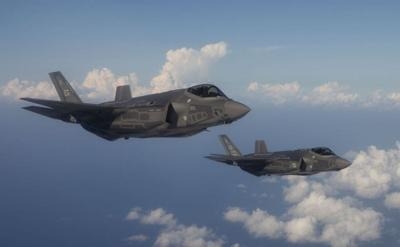Wed, May 17, 2017
Lower Weight Limit Of 136 Pounds Removed After Modifications
Air Force leaders recently removed the restriction that kept pilots weighing less than 136 pounds from flying the F-35A. The restriction was imposed in 2015 due to concerns about the risk during ejections in a portion of the flight envelope.

After rigorous testing to ensure the escape system works reliably and safely in all planned conditions and across all pilot weights, three distinct modifications were implemented. A switch was installed on the seat that slightly delays parachute deployment at high speeds and decreases parachute opening forces for lightweight pilots. Additionally, a head support panel has been mounted on the rear risers of the parachute to prevent the pilot’s head from moving backwards during an ejection. Finally, the overall helmet weight has been reduced through both the reduction of internal strapping material and the removal of an additional external visor, which decreases injury risk during parachute opening.
“I have personally briefed every single F-35 pilot in the United States Air Force about these changes to their ejection seat, and I’m confident our pilots are no longer concerned with the safety of the F-35 ejection system. I've flown in this seat myself and believe, with these modifications, this is the safest ejection seat I've ever flown,” said Brig. Gen. Scott L. Pleus, the F-35 Integration Office director.
In July 2015, during the manufacturer’s ongoing testing, analysis identified an unacceptable risk of neck injury during parachute deployment/opening for pilots weighing less than 136 pounds. The requirement is for the seat to be certified for any pilot weighing between 103 and 245 pounds.
Air Force headquarters and wing leadership took immediate action to ensure pilot safety and work with the manufacturer to meet requirements for the seat. The F-35 Joint Program Office has been working in concert with contractors to develop options to reconfigure the ejection system.
The new ejection seats are already being retrofitted into the existing fleet, and the lightweight helmets are available in pre-production now, while full production starts later this year. The Air Force has received more than 100 F-35As to date, trained more than 400 pilots and accumulated more than 40,000 flight hours.
(Source: USAF news release. Image from file)
More News
He Attempted To Restart The Engine Three Times. On The Third Restart Attempt, He Noticed That Flames Were Coming Out From The Right Wing Near The Fuel Cap Analysis: The pilot repor>[...]
Make Sure You NEVER Miss A New Story From Aero-News Network Do you ever feel like you never see posts from a certain person or page on Facebook or Instagram? Here’s how you c>[...]
From 2009 (YouTube Edition): Leading Air Show Performers Give Their Best Advice for Newcomers On December 6th through December 9th, the Paris Las Vegas Hotel hosted over 1,500 air >[...]
Aero Linx: NASA ASRS ASRS captures confidential reports, analyzes the resulting aviation safety data, and disseminates vital information to the aviation community. The ASRS is an i>[...]
“For our inaugural Pylon Racing Seminar in Roswell, we were thrilled to certify 60 pilots across our six closed-course pylon race classes. Not only did this year’s PRS >[...]
 NTSB Final Report: Rutan Long-EZ
NTSB Final Report: Rutan Long-EZ ANN FAQ: Turn On Post Notifications
ANN FAQ: Turn On Post Notifications Classic Aero-TV: ICAS Perspectives - Advice for New Air Show Performers
Classic Aero-TV: ICAS Perspectives - Advice for New Air Show Performers ANN's Daily Aero-Linx (06.28.25)
ANN's Daily Aero-Linx (06.28.25) Aero-News: Quote of the Day (06.28.25)
Aero-News: Quote of the Day (06.28.25)



